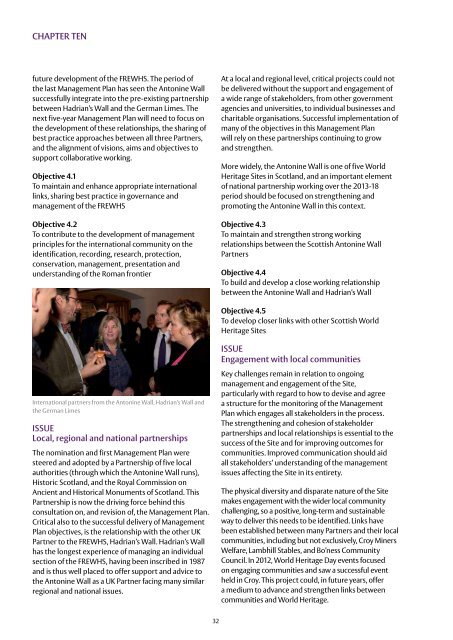The Antonine Wall Management Plan 2013-18 - Glasgow City Council
The Antonine Wall Management Plan 2013-18 - Glasgow City Council
The Antonine Wall Management Plan 2013-18 - Glasgow City Council
Create successful ePaper yourself
Turn your PDF publications into a flip-book with our unique Google optimized e-Paper software.
chapter ten<br />
future development of the FREWHS. <strong>The</strong> period of<br />
the last <strong>Management</strong> <strong>Plan</strong> has seen the <strong>Antonine</strong> <strong>Wall</strong><br />
successfully integrate into the pre-existing partnership<br />
between Hadrian’s <strong>Wall</strong> and the German Limes. <strong>The</strong><br />
next five-year <strong>Management</strong> <strong>Plan</strong> will need to focus on<br />
the development of these relationships, the sharing of<br />
best practice approaches between all three Partners,<br />
and the alignment of visions, aims and objectives to<br />
support collaborative working.<br />
Objective 4.1<br />
To maintain and enhance appropriate international<br />
links, sharing best practice in governance and<br />
management of the FREWHS<br />
Objective 4.2<br />
To contribute to the development of management<br />
principles for the international community on the<br />
identification, recording, research, protection,<br />
conservation, management, presentation and<br />
understanding of the Roman frontier<br />
At a local and regional level, critical projects could not<br />
be delivered without the support and engagement of<br />
a wide range of stakeholders, from other government<br />
agencies and universities, to individual businesses and<br />
charitable organisations. Successful implementation of<br />
many of the objectives in this <strong>Management</strong> <strong>Plan</strong><br />
will rely on these partnerships continuing to grow<br />
and strengthen.<br />
More widely, the <strong>Antonine</strong> <strong>Wall</strong> is one of five World<br />
Heritage Sites in Scotland, and an important element<br />
of national partnership working over the <strong>2013</strong>-<strong>18</strong><br />
period should be focused on strengthening and<br />
promoting the <strong>Antonine</strong> <strong>Wall</strong> in this context.<br />
Objective 4.3<br />
To maintain and strengthen strong working<br />
relationships between the Scottish <strong>Antonine</strong> <strong>Wall</strong><br />
Partners<br />
Objective 4.4<br />
To build and develop a close working relationship<br />
between the <strong>Antonine</strong> <strong>Wall</strong> and Hadrian’s <strong>Wall</strong><br />
Objective 4.5<br />
To develop closer links with other Scottish World<br />
Heritage Sites<br />
International partners from the <strong>Antonine</strong> <strong>Wall</strong>, Hadrian’s <strong>Wall</strong> and<br />
the German Limes<br />
Issue<br />
Local, regional and national partnerships<br />
<strong>The</strong> nomination and first <strong>Management</strong> <strong>Plan</strong> were<br />
steered and adopted by a Partnership of five local<br />
authorities (through which the <strong>Antonine</strong> <strong>Wall</strong> runs),<br />
Historic Scotland, and the Royal Commission on<br />
Ancient and Historical Monuments of Scotland. This<br />
Partnership is now the driving force behind this<br />
consultation on, and revision of, the <strong>Management</strong> <strong>Plan</strong>.<br />
Critical also to the successful delivery of <strong>Management</strong><br />
<strong>Plan</strong> objectives, is the relationship with the other UK<br />
Partner to the FREWHS, Hadrian’s <strong>Wall</strong>. Hadrian’s <strong>Wall</strong><br />
has the longest experience of managing an individual<br />
section of the FREWHS, having been inscribed in 1987<br />
and is thus well placed to offer support and advice to<br />
the <strong>Antonine</strong> <strong>Wall</strong> as a UK Partner facing many similar<br />
regional and national issues.<br />
Issue<br />
Engagement with local communities<br />
Key challenges remain in relation to ongoing<br />
management and engagement of the Site,<br />
particularly with regard to how to devise and agree<br />
a structure for the monitoring of the <strong>Management</strong><br />
<strong>Plan</strong> which engages all stakeholders in the process.<br />
<strong>The</strong> strengthening and cohesion of stakeholder<br />
partnerships and local relationships is essential to the<br />
success of the Site and for improving outcomes for<br />
communities. Improved communication should aid<br />
all stakeholders’ understanding of the management<br />
issues affecting the Site in its entirety.<br />
<strong>The</strong> physical diversity and disparate nature of the Site<br />
makes engagement with the wider local community<br />
challenging, so a positive, long-term and sustainable<br />
way to deliver this needs to be identified. Links have<br />
been established between many Partners and their local<br />
communities, including but not exclusively, Croy Miners<br />
Welfare, Lambhill Stables, and Bo’ness Community<br />
<strong>Council</strong>. In 2012, World Heritage Day events focused<br />
on engaging communities and saw a successful event<br />
held in Croy. This project could, in future years, offer<br />
a medium to advance and strengthen links between<br />
communities and World Heritage.<br />
32












![Elgin Cathedral Wedding Brochure [pdf, 544kb] - Historic Scotland](https://img.yumpu.com/22301571/1/190x151/elgin-cathedral-wedding-brochure-pdf-544kb-historic-scotland.jpg?quality=85)



